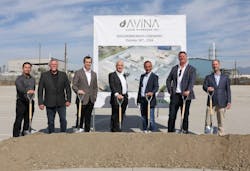Green Hydrogen Startup Unveils H2 Construction Plans near Port of Long Beach
Avina Clean Hydrogen is now detailing its plans for a green hydrogen project in the City of Vernon, 10 miles from the Port of Long Beach in Southern California, as part of its target to decarbonize heavy-duty transport and support California’s clean energy goals.
The facility is designed to produce up to 4 metric tons per day (MTPD) of compressed green hydrogen through electrolysis. To be considered truly green hydrogen, the H2 must be generated by electrolyzers which are powered by carbon-free resources such as hydro, wind, solar or nuclear.
Once operational, Avina’s Vernon Project will be one of the integrated electrolytic hydrogen production and refueling sites globally, supplying critical infrastructure to replace diesel trucking miles with hydrogen miles.
The facility is expected to offset about 130,000 metric tons of CO2 emissions annually, improving air quality in the local communities. The project is scheduled to commence construction and begin commercial operations from July 2025, considering environmental permits.
“Our facility’s strategic location in Southern California allows us to serve critical transportation corridors and urban markets, helping meet the growing demand for clean hydrogen across the region,” said Vishal Shah, Founder, and CEO of Avina Clean Hydrogen, in a statement.
The Ports of Long Beach and Los Angeles, two of the world's busiest for global shipping, both are aiming for carbon reduction and distributed energy goals. The Port of Long Beach's projects include hydrogen, electrification and microgrids.
Hydrogen fuel cell technology, which converts fuel into electricity via an electrochemical process, promises longer driving range and shorter refueling time for vehicles. Some detractors point out that while hydrogen does not emit carbon dioxide, it does contain other elements and also is short on actual infrastructure to support fueling.
The cost of green hydrogen also is high, but more carbon-intensive gray hydrogen (often generated from natural gas) is close to only $1.50 per kilogram. The U.S. Department of Energy under the Biden Administration is supporting green hydrogen development and hopes to drive costs down to $1 per kilogram by 2030, according to reports.
Avina Clean Hydrogen was started two years ago by leaders with investment engine Hydrogen Technology Ventures to focus on both H2 and ammonia development and production. The platform’s founders say they want to invest $1 billion in green ammonia and hydrogen plants by next year.
So far, Avina Clean Hydrogen has announced projects in California and Texas, as well as collaborations with industry players such as Plug Power, Chart Industries and KBR.
Track Green H2 Projects by subscribing to our free E-Newsletter






